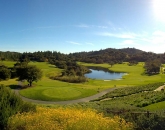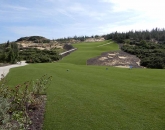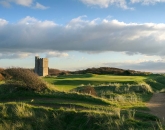 A Brief History
A Brief History
Turnberry Golf Club was established in 1902 when Willie Fernie of Troon was commissioned by the third Marquess of Ailsa to lay out a championship length course on part of the former Culzean Estate. In 1906, the Turnberry Hotel opened, and in those days, there was even an impressive covered link-way which connected the hotel to the adjacent railway station. Wealthy Edwardian guests would not arrive at this hotel wet and bedraggled.
Turnberry twice came close to extinction; it was requisitioned during both World Wars and used as an airbase. During World War II, a number of holes were flattened and turned into expansive concrete runways. It was the tenacity of the then owners that saved the course. Philip Mackenzie Ross was given the task of returning the flattened land back to its former glory. It was a huge task, but in 1951 after two years of intensive work, the links reopened. 26 years later, Turnberry was hosting its first Open Championship.
Time for a Revamp
In preparation for hosting the 2009 Open Championship, Turnberry's Ailsa Course has undergone a number of adjustments designed to ensure that, as one of Britain's finest links, it continues to challenge modern professionals. The most extensive changes are on the 10th, 16th and 17th holes, though most have been enhanced in some way.
“Today's professionals are bigger, stronger, fitter, have more technology at their command, and it's very important that we keep our great links courses relevant to the modern-day professional,” said the R&A's Chief Executive, Peter Dawson. “We've been doing that at every Open venue, with Turnberry having had a considerable number of changes since the 1994 Open Championship.”
The 10th has been redesigned to bring the coastline into play and now requires at least a 200-yard carry over the rocks from a tee perched on an outcrop by the lighthouse. The fairway has been moved closer to the beach to tempt longer players to cut off more of the corner, and three new fairway bunkers force a decision to be made between a safer tee shot with a longer approach or a riskier, braver and more aggressive drive.
Significant changes have also taken place at the 16th and 17th holes. The shape of the 16th has been radically altered and it now doglegs right from a repositioned tee around newly-created dunes and hollows. About 45 yards have been added along with a new bunker left of the fairway. The bunker, which used to guard the left side of the old fairway, now protects the right edge of the new one.
The realignment of the 16th has allowed a new back tee to be constructed on the 17th, extending the hole by 61 yards. A newly-constructed approach bunker, along with another to the front and left of the putting surface, adds difficulty to the second shot.
Including those on the 10th and 16th, a total of 23 bunkers have been added on holes 1, 3, 5, 8, 14 and 18, with two removed at the 3rd and 14th, making players think more about their course-management strategy. Though many Open Championship courses have upwards of 120 bunkers, Turnberry still has a mere 65, testament to the natural test the landscape provides.
New tees have also been introduced at holes 3, 5, 7, 8, 14, and 18, extending the course to 7,204 yards, 247 yards or 3.5% longer than when the Open was last played at Turnberry in 1994.
Pages
Click here to see the published article.











